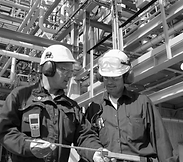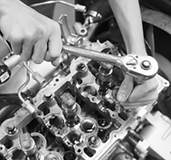Engineering and Technology Quarterly Reviews
ISSN 2622-9374




Published: 11 April 2023
The Effect of Rolling Temperature and Rolling Ratio on Hardness and TRS of 90 micrometer Grain Size on B4C 5 percent Reinforcement Copper Matrix Composite
Özkan Eski, Hasan AlSead Ibrahim Enbia
Kastamonu University, Turkey

Download Full-Text Pdf
10.5281/zenodo.7812678
Pages: 9-20
Keywords: Metal Matrix Composites, Cu, B4C, Cold Pressing, Hot Rolling
Abstract
This study investigates how adding boron carbide (B4C) 5%wt. with a grain size of 90µm, affected the mechanical and physical characteristics of cold-pressed copper boron carbide (Cu-B4C) compounds, including their fine structure, hardness, and density. Commercial Cu powders with a particle size of 40 µm were modified by adding 5% by weight of B4C, which has a particle size of 90µm. For 120 minutes, the Cu-B4C compounds were sintered in argon at 850°C. The values obtained before and after hot rolling were compared. Some samples were hot-rolled at rolling temperatures of 600°C, 700°C, 800°C with rolling pressures of (10%,20%,30%,40%). Sintered materials before and after hot rolling were examined, using SEM-EDS, to compare density, hardness, and bending resistance. It was discovered that B4C was evenly distributed throughout the Cu matrix in the SEM-EDS images that were obtained. As the B4C ratio increased, the density of the original materials reduced, and their porosity increased, the hardness of the composites also increased. With an increase in the rolling ratio and the rolling pressure ratios by (10%,20%,30%, 40%), the values of hardness and flexural strength of the rolled samples fell, and the hardness decreased at 800°C for all the samples that were exposed to these factors (Saravanapandi Solairajan.Aa et al., 2007) (Chandra et al., 2015).
References
Altinsoy, I., Celebi Efe, F. G., Aytaş, D., Kılıç, M., Ozbek, İ., & Bindal, C. (2013). Some Properties of Cu-B4C Composites Manufactured by Powder Metallurgy. Periodicals of Engineering and Natural Sciences (PEN), 1(1), 34–38. https://doi.org/10.21533/pen.v1i1.14
Balalan, Z., & Gulan, F. (2019). Microstructure and mechanical properties of Cu-B4C and CuAl-B4C composites produced by hot pressing. Rare Metals, 38(12), 1169–1177. https://doi.org/10.1007/s12598-019-01287-2
Celebi Efe, G., Altinsoy, I., Ipek, M., Zeytin, S., & Bindal, C. (2012). Effects of SiC particle size on properties of Cu-SiC metal matrix composites. Acta Physica Polonica A, 121(1), 251–253. https://doi.org/10.12693/APhysPolA.121.251
Çelık, E., & Aslan, A. K. (2017). The effect of porosity and cu rate on microstructure and mechanical properties of co alternative powder metallurgy compound. Science of Sintering, 49(3), 225–234. https://doi.org/10.2298/SOS1703225C
Chandra, B., Kumar, J., Singh, H., & Kumar, J. (2015). Production technologies of metal matrix composite-A Review. 4th International Conference on Advances in Materials and Manufacturing Technology (AMMT-14), 5762(June 2015), 9.
Chen, H. S., Wang, W. X., Nie, H. H., Zhou, J., Li, Y. L., Liu, R. F., Zhang, Y. Y., & Zhang, P. (2018). Microstructure evolution and mechanical properties of B4C/6061Al neutron absorber composite sheets fabricated by powder metallurgy. Journal of Alloys and Compounds, 730, 342–351. https://doi.org/10.1016/j.jallcom.2017.09.312
ESKi, Ö., & ELHEMSHERI, M. A. M. (2021). Effect of bonding time and boron carbide percentage on diffusion bonding characteristics for copper/copper matrix composites (Cu + Cu%B4C). Materials Today: Proceedings, xxxx. https://doi.org/10.1016/j.matpr.2021.05.342
Grum, J. (2006). Book Review: Powder Metallurgy and Particulate Materials Processing: The Processes, Materials, Products, Properties, and Applications. International Journal of Materials and Product Technology, 27(3/4), 290. https://doi.org/10.1504/ijmpt.2006.011278
Karakoç, H., Karabulut, Ş., & Çıtak, R. (2018). Study on mechanical and ballistic performances of boron carbide reinforced Al 6061 aluminum alloy produced by powder metallurgy. Composites Part B: Engineering, 148(April), 68–80. https://doi.org/10.1016/j.compositesb.2018.04.043
Konen, R., & Fintov, S. (2012). Copper and Copper Alloys: Casting, Classification and Characteristic Microstructures. Copper Alloys - Early Applications and Current Performance - Enhancing Processes, 3–31. https://doi.org/10.5772/39014
Okay, F., & Islak, S. (2022). Microstructure and Mechanical Properties of Aluminium Matrix Boron Carbide and Carbon Nanofiber Reinforced Hybrid Composites. Science of Sintering, 54(2), 125–138. https://doi.org/10.2298/SOS2202125O
Özkan ESKİa, ISLAKb, S., & URAYLI, Ç. (2017). The Effect of Boron Carbide Amount on Microstructure and Electrical Properties of Cu-B 4 C Composite Materials. 1st International Conference of Advanced Materials and Manufacturing Technologies (ICAMT), 1(October), 25–27.
Ramesh, S., Nayaka, H. S., Anne, G., & Gopi, K. R. (2018). Influence of cold rolling process on microstructure and mechanical properties of Cu-1.5%Ti alloy. AIP Conference Proceedings, 1943. https://doi.org/10.1063/1.5029631
Sahu, P. S., & Banchhor, R. (2016). Fabrication methods used to prepare Al metal matrix composites- A review. International Research Journal of Engineering and Technology, 03(10), 123–132.
Saravanapandi Solairajan.Aa*, A. S., Balavignesh.Pc, P. S., a*, b Assistant Professor, D. of M. E., Infant Jesus college of Engg & Tech, Keelavallanadu, Tuticorin, I., c, d UG Student, D. of M. E., Infant Jesus college of Engg & Tech, Keelavallanadu, Tuticorin, I., & A*solairajan2k@gmail.com. (2007). PROCESSING TECHNIQUES AND APPLICATIONS OF METAL MATRIX COMPOSITES. 5.
Schwetz, K. A. (2000). Boron Carbide, Boron Nitride, and Metal Borides. Ullmann’s Encyclopedia of Industrial Chemistry. https://doi.org/10.1002/14356007.a04_295
Shorowordi, K. M., Laoui, T., Haseeb, A. S. M. A., Celis, J. P., & Froyen, L. (2003). Microstructure and interface characteristics of B4C, SiC and Al2O3 reinforced Al matrix composites: A comparative study. Journal of Materials Processing Technology, 142(3), 738–743. https://doi.org/10.1016/S0924-0136(03)00815-X
Slipenyuk, A., Kuprin, V., Milman, Y., Spowart, J. E., & Miracle, D. B. (2004). The effect of matrix to reinforcement particle size ratio (PSR) on the microstructure and mechanical properties of a P/M processed AlCuMn/SiCp MMC. Materials Science and Engineering A, 381(1–2), 165–170. https://doi.org/10.1016/j.msea.2004.04.040
Topcu, I., Gulsoy, H. O., Kadioglu, N., & Gulluoglu, A. N. (2009). Processing and mechanical properties of B4C reinforced Al matrix composites. Journal of Alloys and Compounds, 482(1–2), 516–521. https://doi.org/10.1016/j.jallcom.2009.04.065
Wiley, C. S. (2011). HIGH-STRENGTH AND LOW-COST BORON CARBIDE HIGH-STRENGTH AND LOW-COST BORON CARBIDE. May.
Zhang, L., Shi, G., Xu, K., Hao, W., Li, Q., Junyan, W., & Wang, Z. (2020). Phase transformation and mechanical properties of B4C/Al composites. Journal of Materials Research and Technology, 9(2), 2116–2126. https://doi.org/10.1016/j.jmrt.2019.12.042



